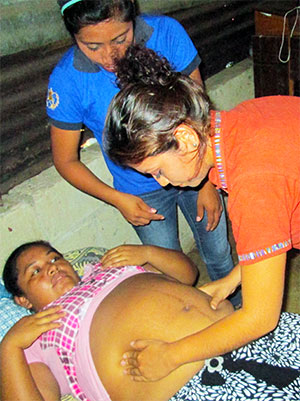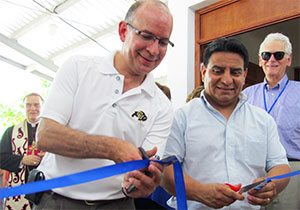Guatemala Clinic Opens
CU Physicians Provide Care

By David Kelly
(May 2014) Standing in Guatemala before a gleaming new building rising from the surrounding ramshackle villages, Gustavo Bolaños delivers a simple yet powerful message to the assembled dignitaries and the banana plantation workers.
“Today we are making the dream of my father a reality,” the chief operating officer of major fruit producer AgroAmérica said in March. “My father Jose Fernando Bolaños believed in the dignity of work, in improving the lives of his employees and the welfare of the community. And this is the result.”
With
The center sits on 10 acres of AgroAmérica land and will be staffed by CU doctors, dentists, nurses, midwives, students and other health professionals rotating through the site. The first physician arrived April 1.
 This is the university’s first permanent presence in a foreign country and a prime example of a successful public-private partnership. Gustavo and Fernando Bolaños donated $1 million to the University of Colorado Denver in 2012 to develop the center, whose initial design was drawn up by students from the CU Denver College of Architecture and Planning. Children’s stepped in to help fund the project.
This is the university’s first permanent presence in a foreign country and a prime example of a successful public-private partnership. Gustavo and Fernando Bolaños donated $1 million to the University of Colorado Denver in 2012 to develop the center, whose initial design was drawn up by students from the CU Denver College of Architecture and Planning. Children’s stepped in to help fund the project.
“This is like a marriage between CU, Children’s and AgroAmérica,” says Stephen Berman, MD, professor of pediatrics and director of the Center for Global Health. The center is part of the Colorado School of Public Health which has overseen most of the project. “It’s a long-term partnership that will require give and take if it is to survive.”
Berman was joined at the grand opening by his wife Elaine; Edwin Asturias, MD, professor of pediatrics and director for Latin America at the Center for Global Health; Judith Albino, PhD, associate dean at the Colorado School of Public Health; Amy Casseri, chief strategy officer for Children’s Hospital Colorado; and Doug Jackson, PhD, CEO of Project C.U.R.E., which donated most of the center’s medical equipment.
“Few universities have this kind of comprehensive relationship in a foreign country,” Asturias says. “This isn’t medical tourism. We are here to stay.”
Asturias, who grew up in Guatemala, says the center represents the best of global health.
“It’s a huge challenge but the kind of challenge we strive for,” he says. “We dreamt big and look what’s been accomplished.”
The clinic includes laboratories, a dental office, exam rooms, a reception
The center sits in an impoverished corner of southwest Guatemala known as the Trifinio region. It’s a hot, humid place where residents often share homes with livestock, drink contaminated water and suffer all the manifestations of poverty.
With the nearest hospital an hour away in Coatepeque, the villages near the plantation have little in the way of health care. Infant mortality rates are high, children die from treatable conditions like diarrhea and pregnant women may never see a doctor.
The center hopes to change much of that. Banana workers and their families who normally pay up to $50 to see a doctor in Coatepeque will now pay just $5 at the facility.
“This is a big help because it’s so close to many communities,” Juan Carlos Cojulun, who lives nearby, says. “It’s much cheaper than going all the way to Coatepeque.”
It also means local health workers, called
That’s just what center director Marco Celada, MD, and two
They drove deep into a steamy banana grove until they found Sandy Mendez, 20, nine months pregnant and in dire need of a checkup.
 She was living in a house of corrugated steel sheets propped precariously against each other. Ducks slumbered beneath a wood-burning stove. A box of chicks peeped nearby. Her husband David Garcia, 26, a banana worker who had been injured by a piece of flying metal, sat nearby with his leg propped up.
She was living in a house of corrugated steel sheets propped precariously against each other. Ducks slumbered beneath a wood-burning stove. A box of chicks peeped nearby. Her husband David Garcia, 26, a banana worker who had been injured by a piece of flying metal, sat nearby with his leg propped up.
“The baby’s head is not in the right place,” Velasquez says.
They decided to return in a few days to see if anything changed.
“One of our big problems is getting to the babies within the first three days of birth,” Celada says. “Fifty percent of deaths occur in the first weeks of life.”
“One of the challenges is effective community engagement and recognizing community in the broadest sense,” Berman says. “The
Berman has had a storied career in global health. He’s set up immunization programs for Colorado children and designed care management systems for pneumonia for the World Health Organization. But this may be his most exciting venture yet.
“It’s rewarding in every possible way,” Berman says. “But you’re only as good as your team, and our team is remarkable.”
The center is already having an impact back home.
Berman recently interviewed a Stanford professor drawn to CU because of the Guatemala project. And two fellows came to work at the university for the same reason.
“I expect this to be a major magnet for new talent,” he says.
Back at the center, the Vatican’s representative in Guatemala, Archbishop Nicolas Thevenin, blesses the clinic and the gates are thrown open.
More than 300 workers and their families rush in. They tour spotless rooms, marveling at a place that now belongs as much to them as anyone.
Albino, assistant dean of the School of Public Health, walks among the throng.
“I am absolutely amazed by what I’ve seen here,” she says. “I’m so thrilled that the Colorado School of Public Health can be a part of this.
This is exactly what we stand for.”